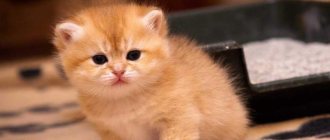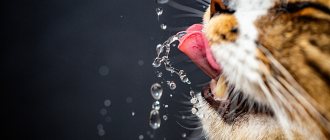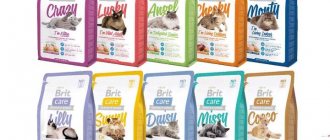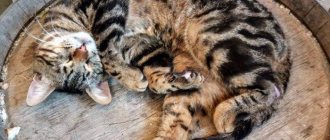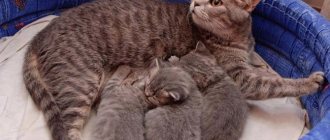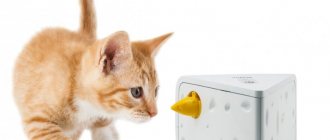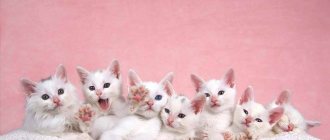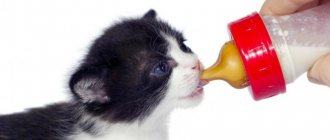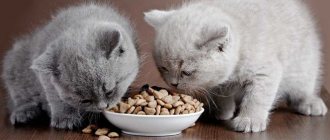- Cats
One of the questions frequently asked to felinologists is: why doesn’t the kitten drink water? Beginning owners worry when it seems to them that the baby is not consuming enough fluids. What if the kitten is sick? Owners experience no less concern if their cat drinks water frequently. How can you tell if your pet is drinking as much as she needs?
The importance of water for a cat's body
The body of any living creature consists of cells. Any cell, in turn, consists of 80% liquid. Each specific cell of the body requires its own set of microelements, which can only enter it when dissolved in water. If a cat does not receive the required amount of water, this can lead to irreversible consequences - drying out, malnutrition, or even cell death. The amount of water your cat drinks is important for blood concentration. The less fluid you consume, the thicker your blood becomes. The heart has difficulty pumping thick blood; oxygen from the blood reaches muscles and tissues more slowly. The heart itself and the entire body as a whole, including the brain, suffer from this due to lack of oxygen. The health of the genitourinary system also depends on fluid intake. A small amount of water leads to a high concentration of salt in the urine, which causes the formation of urinary crystals. Concentrated urine causes urolithiasis in animals, which is very difficult and takes a long time to treat. Neutered cats are especially susceptible to urolithiasis, as they visit the toilet less often and are often less mobile.
Daily fluid intake
According to veterinarians, a cat's daily water intake should be 20-40 milliliters of water per 1 kilogram of weight.
For kittens, this figure is doubled or tripled, since the growing body requires more moisture for new cells. For this reason, the diet of animals under three months of age should consist only of wet food.
The indicated rate of water consumption for a cat is average. Deviations are possible due to a number of aspects.
- Feed. If your pet eats only dry food, the amount of water it consumes should be three times the amount of pellets it eats.
- Dimensions. The lower the weight of the animal, the higher its need for fluid per 1 kilogram of body weight.
- Activity. Exclusively indoor cats are usually less active than their counterparts who periodically walk outside, and therefore drink less.
- Pregnancy and lactation. A pregnant or lactating cat needs plenty of fluids. Moisture is needed to produce additional blood, amniotic fluid and milk for kittens.
- Ambient temperature. During the hot season, cats require more fluid due to the increasing load on the thermoregulatory system. They lick themselves vigorously and, thanks to the evaporation of saliva, tolerate the heat more easily. In addition, a certain amount of liquid evaporates from the surface of the mucous membranes when a hot animal breathes with its mouth open.
How much should a cat drink to be healthy?
Very often, cat owners are alarmed when their pets rarely approach the water bowl. Considering that the norm of fluid intake for a cat is from 30 to 40 ml per kg of live body weight, it is enough to weigh the pet to determine the required amount. But you need to take into account that a cat can partially obtain water from food. Especially if she is offered porridge with broth, kefir, milk and other natural products.
In this case, the cat will approach the bowl of water much less often than when feeding dry food. Dry food requires an increase in daily water intake by almost half.
For example, a cat weighing 4 kg should drink from 120 to 160 ml of water per day. But when feeding dry food, he can drink up to 180 or 240 ml. This will be quite normal.
For small kittens who are still close to their mother cat, it is normal to not want to drink water. After all, they can easily get the required amount of liquid per day from their mother’s milk. As the kitten grows, it will have to start drinking water when switching to “adult” food.
If it seems to you that your cat rarely comes to the water bowl and drinks insufficient amounts of water per day, analyze whether the pet can quench its thirst somewhere else. For example, many cats drink tap water with great pleasure. Cats also really like to drink water from large, tall containers. For example, from buckets, filled bowls, even from a filled bathtub. By nature, cats prefer, whenever possible, to choose rather wide and elevated drinking containers.
General rules
So, it is absolutely normal for cats to drink little but often. If you are thinking about how to get your cat to drink more water, start by calculating its daily fluid intake and compare this figure with the amount that disappears from the bowl.
In hot weather, this observation is more difficult to make because the water evaporates quickly.
There is no need to be alarmed if your cat drinks water with its paw, but make sure that:
- The bowl is not too narrow - the whiskers should not curl when the cat drinks.
- The bowl is too deep - it is better to use wide and shallow bowls.
- The cat does not experience pain when bending its neck.
- The cat's teeth are healthy.
- The water is not too cold.
- The water is clean.
Expert opinion
Irgutanova Nina Nikolaevna
Practicing veterinarian, 13 years of experience.
At any time of the year, especially in winter and summer, the cat should have unhindered access to water. The volume of the drinking bowl should exceed the animal's daily fluid intake by at least 50%.
The bowl should be washed every day, 2-3 times a day in summer. These conditions are especially true for animals kept on dry food, since the granules swell after ingestion, causing extreme thirst.
If you are going on a trip, stock up on clean water to give your cat water on the road. If this moment is missed, do not even think about giving your cat water collected from a puddle or pond.
Most likely, such a decision will lead to dysbiosis and infection with worms. It is worth understanding that water from puddles and standing reservoirs may contain eggs of very dangerous helminths.
Important! Do not allow your cat to drink water from the aquarium or toilet. In the first case, there is a high chance of a bacterial outbreak (the microflora of the aquarium is very specific), in the second, comments are unnecessary.
How to calculate water requirement using formula?
When the question is urgent, and it is fundamentally important for the owner to know the daily rate of water consumption per day by his pet, then there is a simple formula for this: the weight of the cat in grams is multiplied by a coefficient of 0.03 V (ml) = m (g) * 0.03
According to this formula, a 3 kg cat needs approximately 100 ml of water per day. It should be noted that this includes all liquid that enters the body in any form: with milk, canned food, vegetables or other wet food. A kitten needs a little more water per 100 g of weight than an adult pet. On the other hand, a baby who is next to his mother may not drink at all, since his water needs are fully compensated by breast milk, which should also not be forgotten.
Adipsia and hypodipsia
With hyponatremia, regardless of the cause, animals may stop drinking water. Therefore, adipsia induced by these reasons is actually a compensatory mechanism.
Oral health may cause decreased water intake due to mechanical obstructions or pain when drinking.
Adipsia in some cases occurs as a result of poor water quality. It is always important to remember that a cat will refuse water as long as the need for it is satisfied by consuming wet food!
How to provide a cat with water, which is so vital for it, in the required volume?
Many owners complain that their cat prefers a thin stream flowing from the tap to any source of water. This causes some inconvenience, because keeping the water flowing constantly is impractical, and constantly monitoring the cat and opening the water for it as soon as it shows a desire to do so is impossible. In order to solve the problem, it is necessary to understand the reasons for this behavior of the pet. The truth is that any animal will prefer running water to standing water, because it is the richest in oxygen - this is living water, the one that is needed for the health of the body. Cats instinctively feel this. Some of them like to drink from an aquarium, because the water there is either artificially enriched with oxygen, or oxygen is released by aquatic plants. In addition, the water is purified by filters and has a rich microelement composition resulting from the vital activity of fish and plants.
- Cat meowing
- Alexandrian parrot
- Why does a cat need a mustache?
- Rescue dogs
- Hypoallergenic cats
- Why does a cat need a tail?
Thus, in order for the cat to drink enough liquid, it needs to have fresh water at its disposal at all times. How to achieve this? The simplest thing is to put a bowl of the largest, literally “dog” size. The larger the volume of liquid, the longer oxygen remains in it. You can pour water from the tap if you are sure of its quality. If not, filters must be used, but not all animals drink filtered water. Most filters purify water from chlorine and other substances that are used to disinfect it, but while removing harmful things, the filter also removes useful things - salts and microelements. Like boiled water, this water becomes “dead” and therefore unattractive to the cat. The solution may be bottled water, but not just purified water (such as Bon Aqua), but water enriched with microelements (such as Arkhyz, Novoterskaya, etc.) You need to change the water in the bowl as often as possible: several times a day, regardless of whether whether the cat drank or not, because oxygen leaves stagnant water very quickly.
Special devices
To organize a source of “living water” for your cat, you should take advantage of the offers of pet supply manufacturers.
Knowing the problem with drinking in cats, they have long been producing so-called fountain drinkers. All drinking fountains are designed approximately the same, the difference is in shapes, sizes, volumes of liquid, etc. Using an electric pump, water is constantly pumped through a filter that traps wool, dust and other large fractions, and also cleans it of bacteria. Thanks to constant circulation, the liquid is enriched with oxygen, and it needs to be topped up only as natural evaporation occurs - approximately once a week. Depending on the model, a stream of water can simply flow freely from a height, or it can shoot out from the bottom of the drinker, forming an ordinary fountain. In some drinking bowls, this fountain is covered with a dome with a hole at the top, through which water flows freely, constantly forming a thin film on the surface of the dome - cats happily lick it off. This drinking bowl is ideal for long-haired animals, as it does not create splashes at all and allows them to drink without getting their faces wet.
The cost of electric drinkers, of course, is much higher than a regular ceramic bowl - from 2 to 5 thousand rubles. But a device from a good manufacturer will last a long time, and consumes very little electricity - from 2 to 4 W, depending on the size and, accordingly, the volume of the pumped liquid. The only thing you have to regularly spend money on is replacement carbon filters, but in principle you can look at a model without filters at all. In any case, it seems to me that the cat’s health is worth these generally small costs.
Forced additional soldering
If there is a painful condition, the cat should be taken to the veterinarian. If a healthy pet drinks little, then dehydration of the four-legged body can be prevented by supplementing it with water.
Take a syringe with a volume of 10-20 milliliters, fill with water, and replace the needle with a silicone nozzle. To force the cat to open its mouth, place your palm on its head and press the area behind the fangs with your thumb and forefinger. When the animal opens its jaws, insert the syringe nozzle into the gap and supply water in small portions. The animal's muzzle should be slightly raised, and the syringe should be positioned at an acute angle to the head. The water should not go directly into the throat, but behind the pet’s cheek, otherwise the cat may choke. Make sure he has time to swallow. If your cat coughs, let him catch his breath.
Not all animals take this procedure calmly. If your pet actively resists and uses its claws, swaddle it in a towel, leaving only its head free.
Is all water healthy?
When deciding how much a cat should drink, you should choose water that will benefit your pet.
- Boiled water is dead water, according to scientists. It brings less benefits, and after storage for three hours it even becomes harmful. Many veterinarians believe that drinking boiled water can lead to the development of urolithiasis. Owners with the best intentions quite often try to give their pets this kind of water - sometimes this is the reason why the cat does not drink water. By the way, boiled water changes its properties, turning into a “magnet” for bacteria, viruses and other microorganisms contained in the environment.
- Distilled water is lifeless and useless. It is obtained by boiling - the steam is collected and cooled. All microelements remain “overboard”, and they are vitally necessary for the body. In addition, distilled water almost does not conduct current, and the absence of electromagnetic pulses in moisture leads to a slowdown in the movement of moisture in the body.
- Fresh tap water often contains too many heavy salts, metals, chloride compounds and other “nasties” that are absolutely unnecessary for the cat’s body. Sometimes a cat drinks little because of an unpleasant odor or taste that owners do not notice due to prolonged use of tap water.
- Bottled water is a good option if you can find a quality product. Often, Russian manufacturers (which is officially permitted) sell ordinary tap water, industrially purified and enriched with minerals (an excess of which can lead to the occurrence of ICD), under the guise of “natural” water of the first category.
You should choose water of the highest category, marked “drinking”, obtained from underground sources (the well number, chemical composition and place of production must be indicated on the label). So what kind of water should you give? There are two options: filtered or settled tap water. The water needs to stand in the refrigerator, in a tightly closed glass jug, for six to eight hours.
Consequences of fasting
Long-term refusal of food and water cannot do without consequences. Their effect on the animal’s body depends on many factors:
- pet's age;
- size and weight before the hunger strike;
- general health;
- reasons and duration of refusal.
If the pet is lost and returns a month later in a very emaciated state (or it is an emaciated cat picked up on the street), in no case should you give a lot of different food at once.
Prolonged starvation and exhaustion of a cat can lead to the following:
- Significant weight loss.
- Decreased wool quality - the formation of tangles and bald spots, hair loss, unkempt appearance.
- Loss of strength and decline in the overall tone of the body - sometimes the cat does not even have the strength to stand up.
- Deterioration of vision.
- Apathy, lethargy, desire for solitude.
- Problems with the gastrointestinal tract, kidneys, liver. They manifest themselves in the form of nausea, vomiting, constipation, and diarrhea.
- Decreased immune defense of the body. Frequent colds and respiratory diseases may appear.
It is advisable that the condition of an emaciated animal be assessed by a veterinarian. At first, you may need to support your pet with vitamin injections or intravenous infusions of special solutions. The specialist will also help you choose the right diet to quickly return the animal to a normal, fulfilling life.
Natural diet
Drawing up a complete diet with a natural type of nutrition requires compliance with certain rules and patience. Representatives of the cat family are known to be conservative and therefore do not require variety in food. Once properly prepared, the diet can be used by the owner constantly.
Usually a pet goes to a new home at the age of 2-3 months. During this period, the frequency of feeding the animal is 4–5 times a day, and a sufficient amount of food is 180–200 grams. For large kittens, for example, the Maine Coon breed, the daily amount of food should be approximately 230 grams.
At 4–5 months, the frequency of food intake by animals can be reduced to 3–4 times. A pet should receive up to 240 grams of food from natural products per day. After 6 months and up to a year, a three-time meal plan is suitable for a cat. After a year, the pet becomes an adult and should eat no more than twice a day. Of the 200–250 grams of daily food volume, protein foods should account for 100–150 grams. An adult animal does not need as much energy as a furry baby, so its caloric intake should be 80 kcal. The exception is females bearing offspring and lactating - they should receive approximately 2 times more energy from food.
To maintain your pet's health, it is very important that he always has access to water. It needs to be changed 2 times a day
Table: allowed and prohibited foods in cat food
| Authorized products | Prohibited Products |
| Lean meat (rabbit, turkey, beef, chicken) – boiled or frozen. | Fat meat |
| Sea fish (boiled only). | Cow's milk |
| Low fat fermented milk products. | Bread, pasta, sweets (any) |
| Boiled yolk. | Salt, spices |
| Offal. | Onion garlic |
| Herbal products (except prohibited ones) | River fish |
| Porridge | Potato |
| Oils - olive, flax, sea buckthorn. | Mushrooms, legumes |
| Canned food, smoked meats |
Vegetables, such as carrots, pumpkin or zucchini, can be given raw or boiled. It is better to give plant food in tandem with meat or cereals - this way the animal will be more willing to eat it.
The animal should be accustomed to vegetables from childhood, and in order for the cat to be more willing to consume plant products, you need to mix them with meat
Contrary to popular belief that cats are big fans of milk, giving this product to a kitten after three months is not recommended. As felines age, they develop lactose intolerance and if they consume milk, cats may have digestive problems.
An owner who feeds his pet natural products must take care to enrich the food with vitamins. Vitamins A, C, E, categories B and D, as well as calcium, iron, taurine, potassium, phosphorus, magnesium bring particular benefits to the animal’s body. A veterinarian will help you choose the right drug. The most popular vitamin complexes include Beaphar Kitty's Mix, Polidex Immunity up, Doctor Zoo, Radostin.
Example of an optimal menu
To save time, you can prepare balanced nutritional formulas in advance and then freeze them. The following recipes, recommended by experts, fully satisfy the cat's needs:
- A mixture of beef, rice or buckwheat and vegetables. Meat - 2 kg, cereal - 200 grams, vegetables (any allowed) - 500 grams should be boiled separately. Then the products should be minced and divided into portions and frozen. For a pet weighing 3–5 kg, this amount of food is enough for 7 days.
- A mixture of 1 kg chicken fillet, 100 grams of boiled rice and 150 grams of vegetables. Scroll through all the ingredients, form them into meatballs and boil. Next, balls of meat, cereals and vegetables should be cooled and frozen.
In addition to meat, plant products and cereals, the animal's diet should include at least 30 grams (daily dose) of fermented milk products.
Recently a new pet appeared in our house - a mixed-breed kitten. His mother is a purebred “British”, and his father is a mongrel cat. We chose to feed the animal with regular products. His diet consists of boiled chicken, well-boiled buckwheat with vegetables - carrots or zucchini, and 1% fat kefir. There is always water in the second bowl. All types of food Bagel - that’s the kitten’s name; he eats willingly, of course, meat with great pleasure. His fur is thick and shiny, the kitten is active - sometimes even excessively. The animal's stool is regular. We enrich our pet's food with Gimpet Baby Tabs vitamins.
Diagnosis of possible diseases
If you are concerned about any behavioral reactions of this kind, do not put off visiting your veterinarian for too long. In such cases, it is easy to lose time irrevocably, which will lead either to an advanced chronic illness or even to the death of your pet.
What to pay attention to
Pollakiuria is usually only the “first sign” in a series of large number of symptoms that should be paid close attention to. If visually one can only assume the presence of a disease, then it can be excluded or confirmed using modern diagnostic methods
Be attentive to your pet - this will keep him healthy
Table: diseases that cause frequent urination
| Disease | Symptoms | Diagnostic methods |
| Enuresis |
|
|
| Cystitis |
|
|
| Urolithiasis disease |
|
|
| Tumors |
|
|
But for self-education, it will be useful to have an idea of what normal urine test parameters should be for a healthy cat.
A urine test can tell you a lot about your pet's health.
Table: deciphering the analysis of cat urine at the household level
| Index | Norm | Notes |
| Density | 1.020–1.035 | Density readings indicate how concentrated various substances dissolved in urine are and whether the kidneys are functioning normally |
| Color | Straw yellow |
|
| Transparency | Absolute | Must not be:
|
| Acid reaction | pH 6 – 7.5 | This indicator demonstrates the balance of acids and alkalis in the urine formula - slightly sour urine is considered normal for cats. Acidity may vary slightly with diet |
| Protein | Not higher than 0.3 g per 1 liter | High protein content is a warning sign of kidney pathology |
| Glucose | Must be missing | The presence of glucose in the urine most often indicates that the animal is developing diabetes mellitus. |
| Red blood cells | Must be missing | Red blood cells in a cat’s urine indicate the following diseases:
|
| Leukocytes | Must be missing | Leukocytes in a cat’s urine are an indicator of the following diseases:
|
| Bacteriuria | Not higher than 10 thousand units. bacteria in 1 ml of urine | Higher rates indicate infection of the animal with pathogenic microflora |
Veterinarian's verdict
The main task of a veterinarian is to exclude the most dangerous diseases, and once they are diagnosed, then immediately prescribe treatment. If the symptoms are unclear, but there is reason to suspect a disease, then after a visual examination the animal will be offered a standard set of studies:
- blood chemistry;
- general urine analysis;
- Ultrasound;
- X-ray;
- hormone analysis;
- analysis of acetone levels, acid-base balance;
- study of the ratio of urine and fluid intake.
X-ray shows the presence of stones in a cat, and at the same time the development of pleurisy
Restoring the cat's appetite
If there is no appetite, the cat should drink a lot of water, but owners can stimulate the appetite for food.
Here are some ways:
- Bring your pet near the food, maybe he just didn’t smell the food. Pet him, offer him food and water, but don’t force him in.
- Favorite treat. Is there something your kitten never gives up? It's time to get this food out of the bins.
- Sometimes it helps to warm up food and hand feed.
- For small kittens, you can offer food from a syringe or spoon.
- Appetite stimulants (catnip). Do not use it on your own, you must first rule out any diseases, that is, consult a doctor.
- Special medications to increase appetite. Only after examination by a veterinarian, as they can harm your pet.
When should you panic and rush to the hospital?
How many days does your pet go without food? Maybe it's time to go to the hospital?
Let's list the symptoms when you need to urgently go to the vet:
- Refusal to eat and water at the same time; you can’t even get something to drink from a syringe.
- Check your nose. A healthy pet is wet and cool, a sick pet is dry and warm.
- To measure the temperature. Typically in cats it varies from 37 to 38 degrees, although this is an individual indicator.
- Diarrhea and vomiting are signs of simple poisoning or more serious diseases, such as infections.
- Urination. Run to the doctor if it is frequent, infrequent or with discharge.
- Weakness and lethargy.
